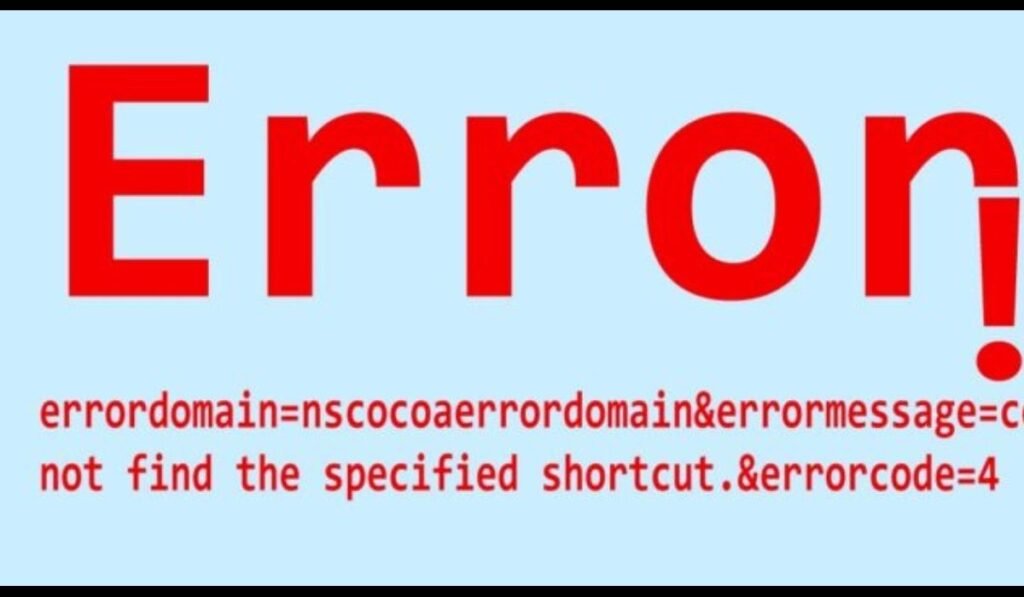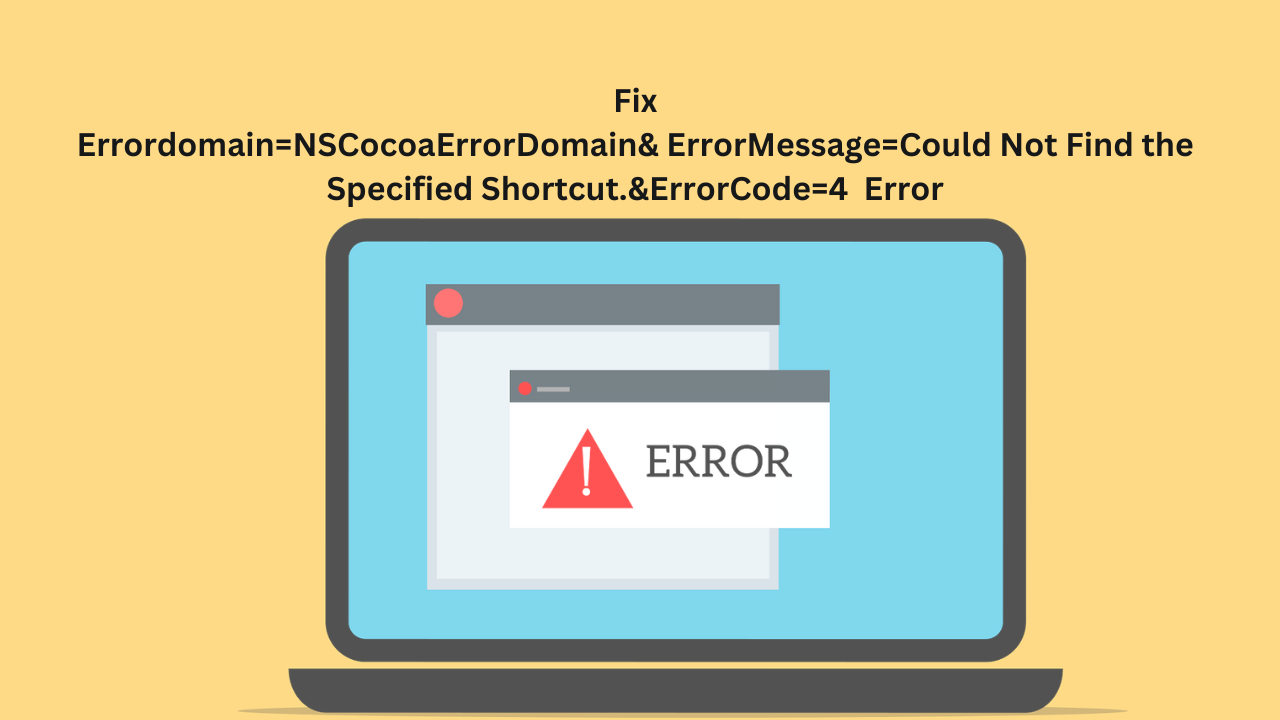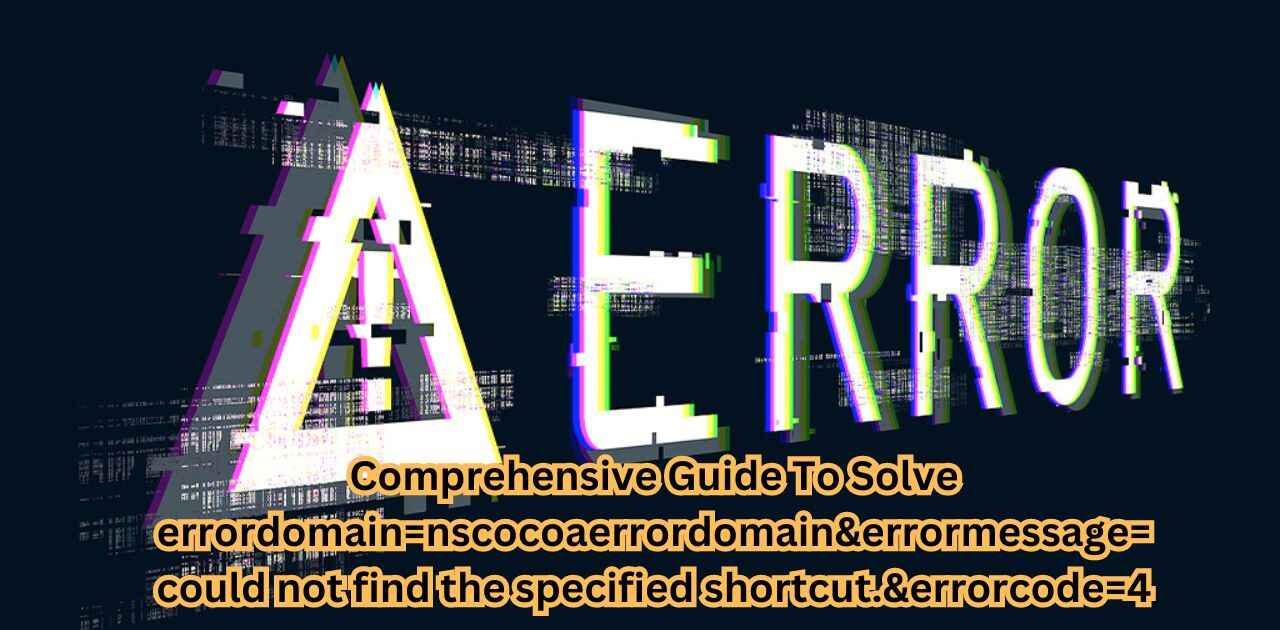
- errordomain=nscocoaerrordomain: errordomain=nscocoaerrordomain&errormessage=could not find the specified shortcut.&errorcode=4, This indicates the error domain within which the error occurred. In macOS/iOS development,
NSCocoaErrorDomainis a common error domain that deals with errors related to Cocoa framework operations. - errormessage=could not find the specified shortcut.: This part specifies the error message associated with the error. In this case, it indicates that the specified shortcut could not be found. It’s likely referring to a specific functionality or feature within an application or system where a shortcut is expected but cannot be located.
- errorcode=4: This specifies the error code associated with the error. Error codes are numerical representations used to identify specific errors. In this case, the error code 4 is being reported. The meaning of the error code depends on the context of the software application or system in which it occurs. Developers typically define error codes to help diagnose and handle errors programmatically.

Overall, this message indicates that within the Cocoa framework (commonly used in macOS/iOS development), there was an error related to the absence of a specified shortcut, identified by the error code 4. This information would typically be useful for developers debugging their applications to understand what went wrong and potentially take corrective actions.
Error messages are a common occurrence in software development, serving as clues to identify and troubleshoot issues within applications. Among the myriad of error messages, those originating from macOS and iOS development often follow a structured format, providing valuable insights into the nature of the problem. One such message is “errordomain=nscocoaerrordomain&errormessage=could not find the specified shortcut.&errorcode=4”. In this article, we’ll delve into the intricacies of this error message, dissecting its components, exploring its implications, and discussing potential strategies for resolution.
Must Read=geekzilla podcast
Understanding the Components
- errordomain=nscocoaerrordomain: This component indicates the error domain, specifying the area within which the error occurred. In macOS/iOS development,
NSCocoaErrorDomainis a predefined error domain that encompasses errors related to the Cocoa framework, which is fundamental to developing applications for Apple’s platforms. - errormessage=could not find the specified shortcut.: The error message provides crucial contextual information about the nature of the error. In this case, it indicates that the specified shortcut, presumably within the application or system, could not be located. Shortcuts often refer to predefined actions or sequences of operations that users can trigger for efficiency and convenience.
- errorcode=4: Error codes are numerical representations used to categorize and identify specific errors. In this instance, error code 4 is being reported. The interpretation of error codes varies depending on the context of the software application or system in which they occur. Developers typically define error codes to facilitate error handling and debugging.

Implications and Potential Causes
The error message “could not find the specified shortcut” implies that the application or system encountered difficulty in locating a specific shortcut. This could have several implications and potential causes, including:
- Missing or Invalid Shortcut Configuration: The shortcut might be defined or configured incorrectly within the application or system settings, leading to its inability to be found or recognized.
- Runtime Environment Issues: Changes in the runtime environment, such as updates to the operating system or dependencies, could affect the availability or functionality of shortcuts, resulting in errors during execution.
- Permissions and Access Restrictions: The user’s permissions or access rights may not be sufficient to access or utilize the specified shortcut, leading to errors when attempting to invoke it.
- Data Corruption or Loss: If the shortcut’s configuration or associated data becomes corrupted or lost, the application may fail to locate it, triggering the reported error.
- Integration Problems: If the application relies on external services or components for shortcut functionality, integration issues with these dependencies could result in errors related to shortcut retrieval.
Strategies for Resolution
Resolving the error “could not find the specified shortcut” (error code 4) requires a systematic approach to identify and address the underlying cause. Here are some strategies that developers can employ:
- Review Shortcut Configuration: Verify that the shortcut is correctly defined and configured within the application or system settings. Ensure that the specified shortcut exists and is associated with the intended functionality.
- Check Runtime Environment Compatibility: Ensure that the application is compatible with the current runtime environment, including the operating system version and any required dependencies. Update the application if necessary to address compatibility issues.
- Verify User Permissions: Ensure that the user has the necessary permissions and access rights to utilize the specified shortcut. Adjust permissions or access settings as needed to grant appropriate privileges.
- Validate Data Integrity: Check for any signs of data corruption or loss that may be affecting the availability of the shortcut. Restore or recreate the shortcut’s configuration and associated data if necessary.
- Debug Integration Points: If the application relies on external services or components for shortcut functionality, debug the integration points to identify and resolve any issues affecting shortcut retrieval.

FAQ
- *What does “errordomain=nscocoaerrordomain” mean in the error message?
- This component specifies the error domain, indicating the area within which the error occurred. In this case, it pertains to errors related to the Cocoa framework in macOS or iOS development.
- **What is the significance of “errormessage=could not find the specified shortcut.”?
- This part of the error message provides crucial contextual information, indicating that the specified shortcut, typically within an application or system, could not be located.
- **What does “errorcode=4” represent in this error message?
- “errorcode=4” is the numerical representation of the error, serving to categorize and identify the specific issue encountered. It aids developers in diagnosing and troubleshooting errors programmatically.
- **What could be the possible reasons for encountering this error?
- Possible reasons include missing or incorrectly configured shortcuts, runtime environment issues, permissions/access restrictions, data corruption or loss related to the shortcut, or integration problems with external dependencies.
- **How can I troubleshoot the error “could not find the specified shortcut.”?
- You can start by verifying the shortcut’s configuration, checking compatibility with the runtime environment, ensuring appropriate user permissions, validating data integrity, and debugging integration points with external services.
- **Is this error specific to macOS or iOS development only?
- While the error message originates from Cocoa framework used in macOS and iOS development, similar concepts of error domains, error messages, and error codes are prevalent in other software development environments as well.
- **Can updating my operating system resolve this error?
- Updating the operating system may address compatibility issues with the runtime environment, potentially resolving the error if it was caused by such issues.
- **What actions can I take if the shortcut is missing or incorrectly configured?
- You can review and adjust the shortcut’s configuration settings within the application or system to ensure it is correctly defined and associated with the intended functionality.
- **Are there any specific log files or diagnostic tools to help identify this error?
- Check system logs or utilize debugging tools provided by the development environment to gather more information about the error, such as stack traces or error logs.
- **Does this error affect all users or specific user accounts?
- Depending on the cause, the error may impact all users of the application or be specific to certain user accounts based on permissions or access restrictions.
- **Can I customize the error message to provide more detailed information?
- Depending on the application’s design and implementation, you may have the option to customize error messages to provide additional context or instructions for troubleshooting.
- **Are there any known bugs or issues related to this error in Cocoa framework?
- Check the documentation, release notes, and developer forums for any reported bugs or issues related to the Cocoa framework that may be associated with this error.
- **How can I prevent this error from occurring in future releases of my application?
- Implement robust error handling and validation mechanisms, conduct thorough testing to identify and address potential issues early in the development process, and stay informed about updates and best practices in software development.
- **Does restarting the application or system help resolve this error?
- Sometimes, restarting the application or system can resolve transient issues or reset configurations that may be causing the error. However, it may not always be a permanent solution.
- **Can this error be triggered by user input or specific actions within the application?
- Certain user inputs or actions within the application may trigger the error, especially if they involve invoking or interacting with shortcuts that are incorrectly configured or unavailable.
- **Is there a risk of data loss associated with this error?
- The error “could not find the specified shortcut” typically does not imply a risk of data loss. However, it may indicate underlying issues that could potentially lead to data loss if left unresolved.
- **Is there a difference between error code 4 and other error codes in the Cocoa framework?
- Error codes in the Cocoa framework are typically unique identifiers for specific errors. Error code 4, in this case, represents the particular issue of being unable to find the specified shortcut, but other error codes may indicate different types of errors.
- **Can third-party software or extensions cause this error?
- Third-party software or extensions may interfere with the operation of the application or system, potentially leading to errors. Disable or uninstall any such software to see if it resolves the issue.
- **Is there a community or forum where I can seek help for resolving this error?
- Yes, various online communities, forums, and developer support channels exist where you can seek help from other developers who may have encountered similar issues or from experts in macOS/iOS development.
- **Does Apple provide official documentation or support resources for troubleshooting this error?
- Yes, Apple offers official documentation, developer forums, and support resources where you can find guidance and assistance for troubleshooting errors in macOS/iOS development, including those related to the Cocoa framework.
Conclusion
The error message “errordomain=nscocoaerrordomain&errormessage=could not find the specified shortcut.&errorcode=4” provides valuable insights into the nature of the problem encountered within a macOS or iOS application. By understanding its components, implications, and potential causes, developers can effectively diagnose and resolve issues related to missing shortcuts. Through careful review, troubleshooting, and resolution strategies, developers can ensure that their applications deliver a seamless and error-free user experience.



